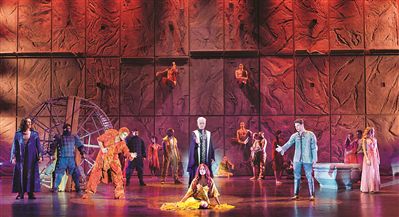Frank Wilczek
 (资料图)
(资料图)
弗兰克·维尔切克是麻省理工学院物理学教授、量子色动力学的奠基人之一。因发现了量子色动力学的渐近自由现象,他在2004年获得了诺贝尔物理学奖。
翻译 | 胡风、梁丁当
中文版
天文学家为红外图像配上颜色,不仅是为了科学研究,也帮助我们欣赏它的美。
詹姆斯·韦伯太空望远镜拍摄的第一组照片真是美不胜收,让人叹为观止。如果你思索一下你到底看到了什么,会更加感到不可思议。
这些图片的制作极富创造力和艺术力。出于科学的考虑,韦伯望远镜利用红外线成像,能够捕捉到可见光看不到的特征。因为宇宙在不断膨胀,从遥远过去宇宙中的初生星系发出的光,被拉伸到电磁光谱的红外区域。最后,这种拍摄必须在太空中进行,以避开其它红外热源的干扰。
可惜我们的眼睛不能直接看到韦伯望远镜拍摄的充满了丰富细节的红外图像。一般来说,红外线是看不见的,我们只能感受到它产生的热效应。(蟒蛇和吸血蝙蝠能够看到红外线,并通过它来定位猎物。)为了弥合人类的感官差异,天文学家们为不同的红外线赋上相应的颜色。这是有科学依据的,因为人类拥有计算机所无法比拟的视觉模式识别能力。经过处理后的图像既愉悦了我们的双眼,又超越了它,让人们能直观地感受到宇宙中隐藏的美,有利于文化传播。
而对科学家和铁杆的科学迷来说,重要的是这些处理过的图像所蕴含的信息。这些详细、定量的信息为我们的计算机与具有分析能力的大脑提供了丰富的资源。韦伯望远镜科学项目将解决很多问题,包括它本身带来的新问题。我个人尤其对两件肯定的事和两个渺茫的可能性感兴趣。
第一个是宇宙的年龄问题。目前,测量宇宙年龄有两种方法。一种是研究宇宙微波背景辐射,这是早期宇宙的信号;一种是研究遥远星系和超新星发出的光谱,这是来自于较近期宇宙的信号。这两种方法测到的宇宙年龄有差异:第一种方法得到的宇宙年龄比后者大。这个差异被称为“哈勃差异”(Hubble tension)。 哈勃差异并不是特别大,大概只有10%,但是它超出了系统测量误差。通过更加复杂和深入的数据分析,韦伯望远镜的观测数据将证实或者纠正近期宇宙的探测结果。
另外,韦伯望远镜的红外成像也为探索其他(相对)寒冷、昏暗的天体打开了新窗口。有一个可能性特别有趣,即研究系外行星(即太阳系外的行星)的大气层。毫无疑问,韦伯望远镜会发现许多新的行星,比如迄今从未看到的类地行星。众所周知,地球上的生命活动剧烈地改变了地球大气层;这种改变主要通过光合作用发生,而普通的化学过程很难导致这种改变。因此,如果韦伯望远镜观测到不寻常的系外行星大气层,意味着在宇宙深处可能有生命的存在。
上述两个方向是肯定会取得进展的。还有两个比较渺茫但蛮迷人的可能性。第一:如果哈勃差异被证实,意味着早期宇宙具有比现在更多的“暗能量”—— 人们认为这种暗物质会加速宇宙的膨胀。这与现有的理论背道而驰。我倒是乐见其成,或许它将为基础物理学注入一些受欢迎的(暗)能量。
第二:众所周知,人类技术正在显著的改变地球的大气层。浩大的工程往往涉及巨大的能量与物质的流动。说不定有一天,人类工程甚至会改变太阳系,而这种变化可以被别的类似韦伯望远镜的仪器从远方检测到。在茫茫的宇宙中,如能觅到知音,难道不是一件最浪漫的事吗?
英文版
Astronomers add color to the infrared images for scientific reasons but also to help the rest of us appreciate their beauty.
The beauty of the first pictures to emerge from the James Webb Space Telescope is breathtaking. And when you reflect on what you’re actually looking at, the pictures are mind-boggling, too.
A lot of creativity and art goes into crafting those images. For very good scientific reasons, the Webb telescope is designed to work mainly with infrared radiation, which gives a picture that complements visible light, illuminating different features. To see the distant past of the universe and catch galaxies in their youth, this is how to look. Light from those sources has been stretched by the universe’s expansion into the infrared region of the electromagnetic spectrum. To view it,you need to go into space and avoid the infrared glare of closer warm bodies.
There is a mismatch between the exquisitely detailed infrared images the Webb scope produces and what human eyes can perceive. We ordinarily feel infrared radiation as heat but don’t see it. (Pythons and vampire bats do, using it to home in on the heat generated by their prey.) To bridge the human sensory gap, astronomer-artists assign visible, false colors to the different sorts of infrared light. The result both caters to our natural vision and transcends it. There is a scientific purpose to that exercise; humans have powers of visual pattern recognition that computers can’t yet match. There’s also, of course, a cultural purpose—to make the hidden beauty of the universe more accessible.
For scientists and hard-core science fans, though, the point is not the processed images but the underlying information. That information, detailed and quantitative, is nourishing food for thought, both for computers and for the more analytical parts of human brains. The scientific program of Webb will address many questions, probably including new ones that its own observations will pose. Personally, I’m especially interested in two “sure things” and two related long shots.
Presently, two different ways of measuring the age of the universe don’t quite agree.Methods based on studying signals from the very early universe (specifically, cosmic microwave background radiation) give a larger value than methods based on studying signals from the relatively recent universe (specifically, distant galaxies and supernovae). The discrepancy, known as the “Hubble tension,” is about 10%—not enormous but larger than the claimed precision of the measurements. Webb observations should significantly firm up—or modify—the recent-universe result, which involves more complicated data analysis.
Webb’s infrared imaging also will open a new window on other (relatively) cold, dim astronomical objects.Especially interesting is the possibility of studying the atmospheres of planets outside our solar system: exoplanets. Webb will surely identify lots of new ones, including small Earthlike planets that so far have been elusive. Life on Earth has drastically changed its atmosphere, mainly through photosynthesis, in ways that ordinary chemistry might find hard to mimic. Unusual exoplanet atmospheres might hint at distant life.
Those are pretty sure bets. Here are two intriguing long shots.First: If the Hubble tension gets firmed up, it could indicate that there was more “dark energy”—a substance thought to accelerate the universe’s expansion —in the early universe than today. That is contrary to existing theory, but I wouldn’t bet against it heavily. It would inject some welcome (dark) energy into fundamental physics.
Second: Notoriously, human technology is beginning to alter Earth’s atmosphere significantly.Big projects can involve big flows of energy and matter, so plausibly someday human engineering will alter the solar system in ways that a Webb-like instrument could detect from afar. Wouldn’t it be poetic for our own restless intelligence to unearth signs of restless intelligence elsewhere?
由于微信公众号试行乱序推送,您可能不再能准时收到墨子沙龙的推送。为了不与小墨失散, 请将“墨子沙龙”设为星标账号,以及常点文末右下角的“在看”。
墨子是我国古代著名的思想家、科学家,其思想和成就是我国早期科学萌芽的体现。墨子沙龙的建立,旨在传承、发扬科学传统,倡导、弘扬科学精神,提升公民科学素养,建设崇尚科学的社会氛围。
墨子沙龙面向热爱科学、有探索精神和好奇心的普通公众,通过面对面的公众活动和多样化的新媒体平台,希望让大家了解到当下全球最尖端的科学进展、最先进的科学思想,探寻科学之秘,感受科学之美。
墨子沙龙由中国科学技术大学上海研究院及浦东新区南七量子科技交流中心主办,受到中国科大新创校友基金会、中国科学技术大学教育基金会、浦东新区科学技术协会、中国科学技术协会及浦东新区科技和经济委员会等支持。
关于“墨子沙龙”

















 营业执照公示信息
营业执照公示信息